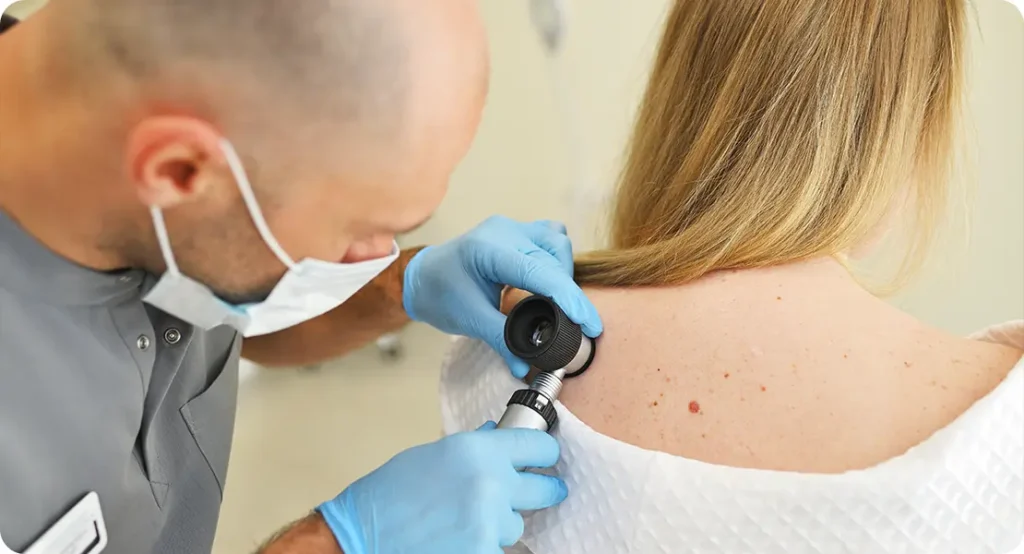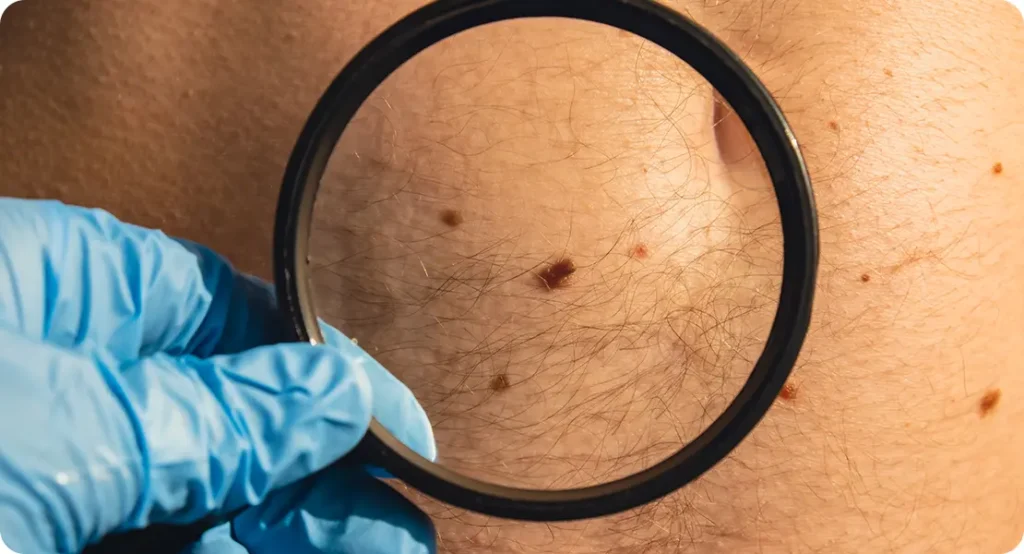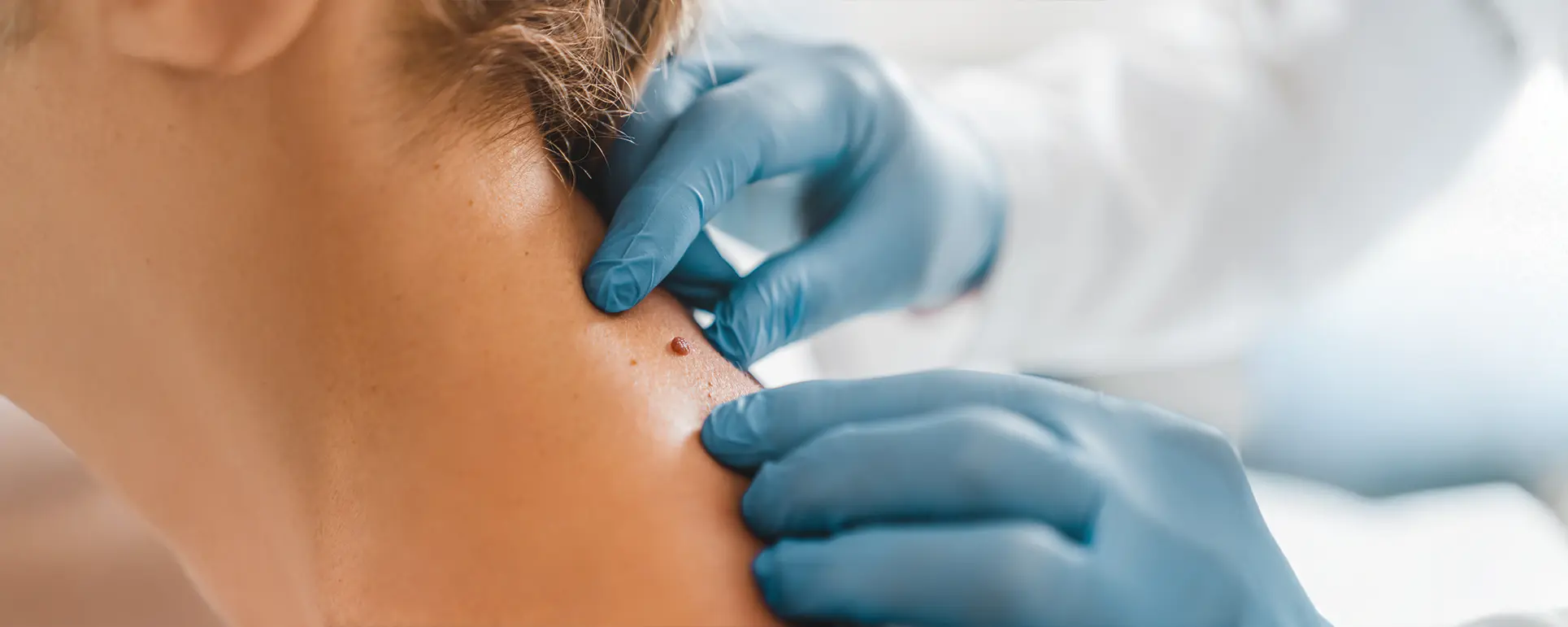Almost everyone has moles some people have just a few, while others have dozens scattered across their skin. Most of the time, these small spots are completely harmless and require no special attention. However, certain changes in the appearance or behaviour of a mole can sometimes indicate a more serious underlying issue, such as skin cancer.
So how can you tell the difference between a harmless mole and one that might need medical attention? The truth is, it’s not always easy to know just by looking. Some moles may grow, change shape, or alter in colour slowly over time, while others may start to itch, bleed, or simply look unusual. That’s why keeping a close eye on your skin and knowing what to look for is so important.
In this guide, we’ll walk you through a practical, easy-to-follow checklist designed to help you assess whether a mole may need to be checked by a professional. From understanding key warning signs to recognising when changes could be a cause for concern, this article aims to give you the confidence to take control of your skin health.
We’ll also take a closer look at how private mole checks work what the consultation involves, how the mole is assessed, and what kind of treatment or follow-up might be recommended if something suspicious is found. Whether you’re simply looking for peace of mind or have already noticed something unusual, this guide will give you a clearer understanding of the steps to take next.
1. The ABCDE Rule: Your First Line of Defence
When it comes to spotting suspicious moles, dermatologists rely on a tried-and-tested system known as the ABCDE rule. It’s a quick and easy way to assess whether a mole might be cause for concern and it’s something anyone can use at home. Let’s break it down:
- Asymmetry: Healthy moles are usually symmetrical if you draw an imaginary line through the middle, both halves should look roughly the same. If one side is noticeably different from the other, that’s a red flag.
- Border: Check the edges of the mole. Are they smooth and well-defined, or are they jagged, irregular, or blurred into the surrounding skin? Uneven borders can be a warning sign of melanoma, a serious type of skin cancer.
- Colour: While most harmless moles are a single shade of brown, look out for moles that contain a mix of colours including black, tan, red, white, or even bluish tones. Uneven colouring could suggest abnormal cell changes beneath the surface.
- Diameter: A mole that’s larger than 6 millimetres in diameter about the size of a standard pencil eraser should be monitored carefully. While not all large moles are dangerous, size combined with other warning signs may be significant.
- Evolving: This is one of the most important signs to watch for. If a mole has changed over time whether in size, shape, colour, texture, or elevation it may indicate a potential issue. Also note any new symptoms, such as itching, bleeding, or crusting.
2. New Moles After Age 30

It’s completely normal for children and teenagers to develop new moles as they grow. In fact, most people will see their mole count increase through adolescence and early adulthood as their skin matures and responds to hormonal changes. However, once you reach your 30s, it becomes less common for new moles to appear and when they do, they may warrant a closer look.
If you notice a brand-new mole after the age of 30, it doesn’t necessarily mean something is wrong. In many cases, adult moles are completely benign and pose no risk at all. But because skin cancer, including melanoma, can sometimes begin as a new mole or pigmented lesion in adulthood, it’s important not to ignore any unexpected developments on your skin.
Here’s what to keep in mind: a new mole that looks unusual, changes quickly, or stands out from your other moles what dermatologists sometimes call the “ugly duckling” sign should be monitored closely. Pay attention to its size, shape, colour, and any changes over time. If it starts to itch, bleed, scab, or become tender, book an appointment with a dermatologist as soon as possible.
In general, a good rule of thumb is this: any new mole appearing after age 30 should be checked, especially if you have a personal or family history of skin cancer, or if you’ve had significant sun exposure over the years. Early detection is key, and it’s always better to be cautious when it comes to your skin health.
3. Bleeding, Itching, or Pain
Moles are typically harmless and don’t cause any discomfort. So when a mole starts to itch, hurt, or bleed for no apparent reason, it’s a clear sign that something has changed and it may need to be assessed by a medical professional.
Occasional irritation from friction (like rubbing against clothing or being accidentally scratched) is one thing, but persistent symptoms without any obvious cause should raise a red flag. If a mole starts to itch regularly, becomes tender to the touch, or begins to scab or ooze even if you haven’t injured it it could indicate inflammation, abnormal cell growth, or, in some cases, early signs of skin cancer.
Bleeding is particularly important to note. A healthy mole shouldn’t bleed on its own. Spontaneous bleeding, especially if the mole also appears larger, darker, crusty, or ulcerated, might suggest that the skin is breaking down beneath the surface something that requires immediate medical evaluation.
Pain is another symptom people often overlook. If a mole becomes sore, throbbing, or painful even without any physical trauma it might be a sign of an internal change that’s worth investigating further.
To put it simply: your skin shouldn’t hurt, itch, or bleed unless there’s a reason. If a mole is showing any of these signs and there’s no clear explanation, don’t wait it out. Book a consultation with a dermatologist for peace of mind and early intervention if needed.
4. Family History of Skin Cancer
Your family’s health history can play a significant role in your own risk of developing certain conditions and skin cancer is no exception. If a close relative, such as a parent, sibling, or child, has been diagnosed with melanoma or another type of skin cancer, your own risk of developing the disease increases.
This doesn’t mean you’ll definitely develop skin cancer, but it does mean you need to be more proactive and vigilant about changes to your skin. Some people inherit genes that make them more susceptible to the effects of UV damage or prone to developing abnormal moles. In these cases, even slightly unusual or borderline moles deserve more attention.
If you have a family history of skin cancer, especially melanoma, regular skin checks should become part of your routine just like dental checkups or eye exams. Keep an eye out for new moles, changes in existing ones, or any of the signs listed in the ABCDE rule. Many dermatologists recommend annual skin exams for individuals with a family history, even if there are no immediate concerns.
Early detection is particularly important if you’re in a higher-risk group. The earlier a skin cancer is spotted, the easier it is to treat successfully. So if you’re ever unsure about a mole and you know that skin cancer runs in your family it’s always best to err on the side of caution.
Remember: prevention starts with awareness, and being aware of your family history is one of the smartest steps you can take toward protecting your skin health.
5. Large or Irregular Birthmarks

Birthmarks are common and usually harmless, but some types especially larger or irregular ones can pose a greater risk when it comes to skin health. In particular, congenital melanocytic nevi, which are moles or birthmarks present from birth, are known to carry a slightly higher risk of developing into melanoma later in life.
The risk is higher if the birthmark is large (typically more than 20cm in diameter), has an unusual texture, or appears irregular in colour or shape. These types of moles may grow proportionally with your body over time and can remain stable for years but that doesn’t mean they should be ignored.
It’s especially important to monitor birthmarks that:
- Appear asymmetrical or oddly shaped
- Contain mixed colours or dark patches
- Are located in areas that are hard to self-check (like the scalp or back)
- Have recently changed in size, colour, or texture
Although most large birthmarks never turn into skin cancer, regular check-ups with a dermatologist are a smart way to stay on top of any changes. In some cases, a dermatologist may recommend digital mole mapping, photographic monitoring, or even biopsy if there’s any concern about transformation.
If you’ve had a large or irregular birthmark since childhood or notice any changes in one you’ve had for years, it’s worth booking a professional skin check for peace of mind. Early detection and expert guidance can make all the difference when it comes to long-term skin health.
6. Mole Mapping in a Private Clinic
If you’re serious about keeping track of your skin health, especially if you have lots of moles or a family history of skin cancer, private mole checks can offer a level of thoroughness and convenience that’s hard to match. One of the most advanced tools available in these clinics is mole mapping technology a highly effective, non-invasive method of monitoring changes in your moles over time.
Mole mapping involves a detailed visual record of your skin using high-resolution, full-body imaging. During your appointment, a trained dermatologist or specialist will capture close-up photographs of individual moles, along with wider body shots to document their exact positions. These images are then stored securely in a digital database.
What makes mole mapping especially useful is its ability to:
- Track even subtle changes in size, shape, or colour over time
- Compare new and old images to detect moles that may be evolving
- Identify high-risk moles early, before they become a problem
- Minimise unnecessary biopsies by offering better long-term evidence
If a mole appears suspicious or has changed between visits, the dermatologist can flag it for further evaluation, which may include a dermoscopic analysis, biopsy, or in some cases, removal. This type of proactive care is particularly valuable for people with atypical moles, a history of sun damage, or a higher personal risk.
The process is quick, painless, and entirely non-invasive no needles, no incisions, and no downtime. Many patients find peace of mind knowing that their skin is being monitored with expert precision and that any potential issues will be spotted early.
In short, mole mapping is a smart, modern way to take control of your skin health especially when time, accuracy, and early detection matter most.
7. When in Doubt, Check It Out
Even with the best checklists and guidelines, there will be times when a mole just doesn’t feel right but you’re not entirely sure why. Maybe it looks slightly different than the others. Maybe it appeared suddenly and hasn’t changed since. Or maybe it’s not doing anything at all, but something about it just makes you pause.
In these situations, it’s always wise to trust your instincts and get it checked. While many skin changes are harmless, the cost of ignoring something that could be serious simply isn’t worth the risk. Catching skin cancer early especially melanoma can make all the difference in successful treatment and long-term outcomes.
The good news is that getting a mole checked is usually quick, straightforward, and painless. In a private clinic setting, appointments are often available without long waiting times, and the consultation may include:
- A detailed visual skin exam by an experienced dermatologist
- Dermoscopic imaging to assess structures beneath the skin surface
- Peace of mind, reassurance, or a clear action plan if further steps are needed
Even if the mole turns out to be completely benign, you’ll walk away with clarity and relief rather than weeks or months of unnecessary worry. And if something needs treatment, you’ve taken a positive, proactive step toward protecting your health.
So remember when in doubt, check it out. It could be the most important five-minute decision you make all year.
Frequently Asked Questions
- What is the best way to monitor moles at home?
Use the ABCDE rule and take regular photos to track any changes. If anything looks different, book a skin check. - Should I worry about a mole that suddenly appears?
Yes, especially if you’re over 30. New moles in adulthood should be monitored closely and reviewed by a dermatologist. - Can a harmless-looking mole still be cancerous?
Sometimes, yes. Not all cancerous moles look unusual. That’s why regular checks are important, especially if you have risk factors. - Is mole mapping safe and accurate?
Absolutely. Mole mapping is a non-invasive, high-tech way to monitor changes over time and detect issues early. - How often should I get my moles checked?
At least once a year or more frequently if you have a personal or family history of skin cancer. - Are itchy moles always a cause for concern?
Itching isn’t always serious, but if it persists or comes with bleeding or colour changes, get it checked. - Can I remove a mole at home?
No. DIY mole removal is unsafe and can delay proper diagnosis. Always see a qualified dermatologist. - Does sun exposure affect mole changes?
Yes. UV radiation can trigger changes in existing moles and cause new ones to form, increasing your risk. - Is it expensive to get a mole checked privately?
Private clinics often offer quick access and comprehensive exams. Prices vary, but many find the peace of mind worth it. - What happens if a mole needs to be removed?
Your dermatologist will explain the options, which may include surgical excision or biopsy, depending on the findings.
Final Thoughts: Trust Your Skin, Trust Your Instincts
Even though most moles are harmless, being proactive can make all the difference. If you’ve noticed changes in a mole, or something just doesn’t feel right, don’t wait. Feel free to reach out to book a consultation with one of our experienced dermatologists your peace of mind could be just one appointment away.
References:
- American Academy of Dermatology Association. (2023). How to spot skin cancer. https://www.aad.org/public/diseases/skin-cancer/find/at-risk
- Cancer Research UK. (2024). Signs and symptoms of melanoma. https://www.cancerresearchuk.org/about-cancer/melanoma/symptoms
- DermNet. (2023). Mole (naevus). https://dermnetnz.org/topics/melanocytic-naevus
- NHS. (2024). Moles. https://www.nhs.uk/conditions/moles/
- Skin Cancer Foundation. (2023). Melanoma Warning Signs and Images. https://en.wikipedia.org/wiki/Melanocytic_nevus?utm_source=chatgpt.com
